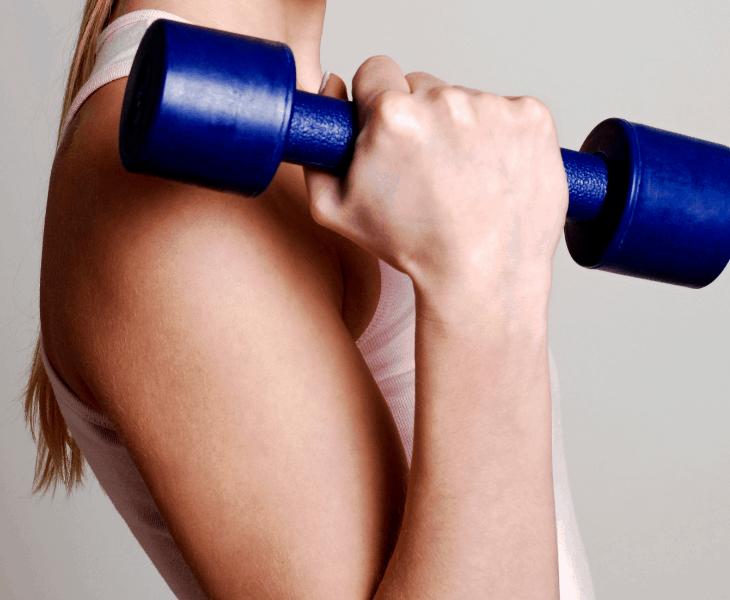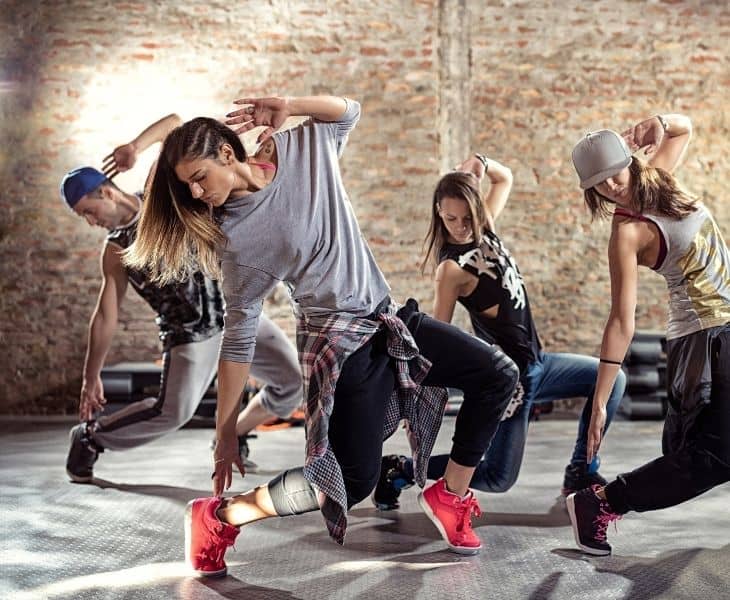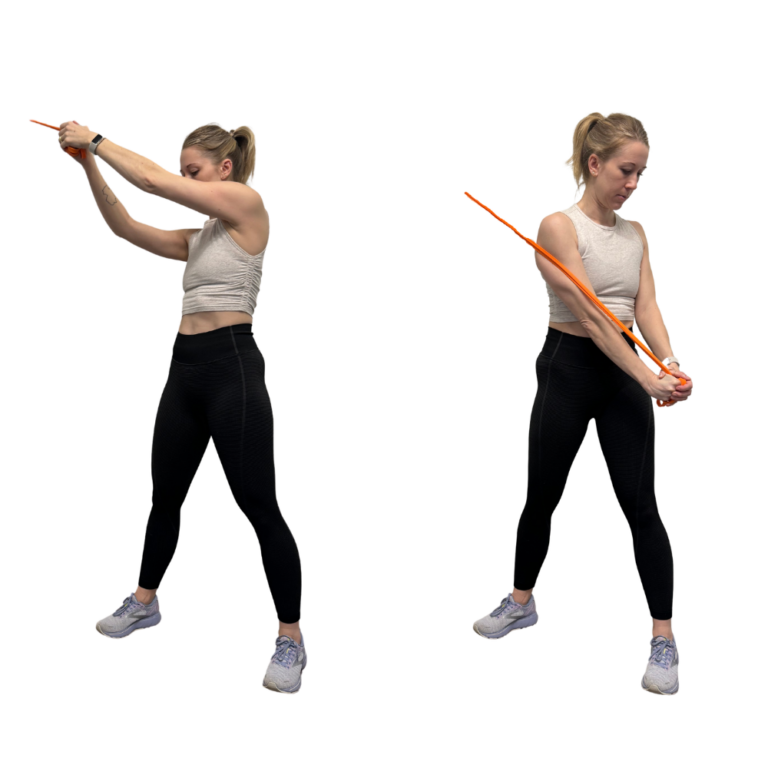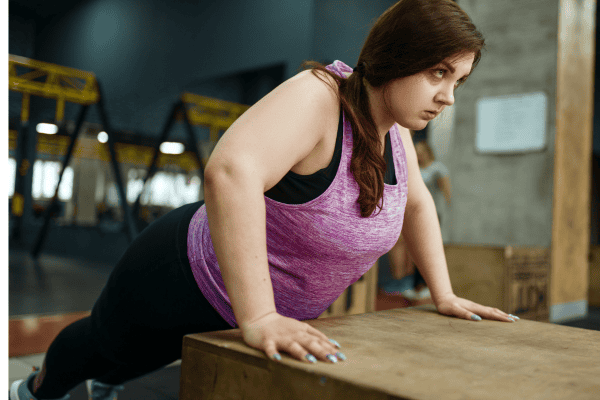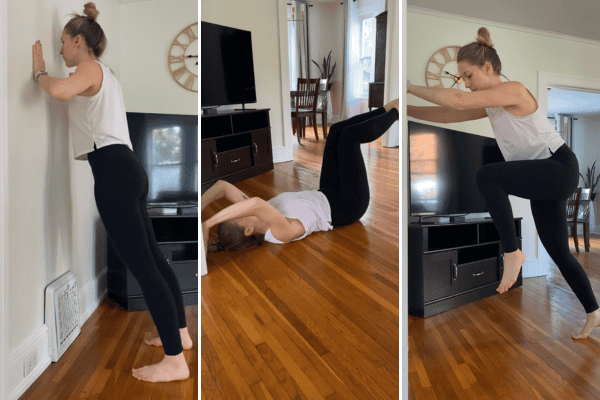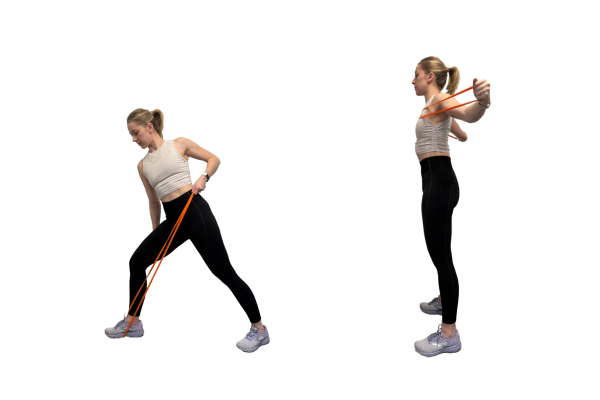Resistance Band Glute Workout for a Strong and Round Booty
If you’re dreaming of a strong butt, yearning to enhance your posture, or simply wish to feel stronger, balanced, and more confident in your daily activities, then this resistance band glute workout is for you.
Picture this: a resistance band glute workout that not only targets those hard-to-reach muscles but also promises convenience and efficiency.
I’ve curated a special list of exercises that are specifically designed to strengthen your glute muscles, effectively turning your living room into your personal gym.
With just a resistance band, you’re all set to embark on this fitness journey from the comfort of your home, requiring minimal equipment and space.
More Resistance Band Workouts:
- Resistance Band Leg Workout
- Resistance Band Core Workout
- Resistance Band Back Workout
- Resistance Band Arm Workout
The Three Glute Muscles Explained
If you’re looking to sculpt a strong butt, understanding the anatomy of your glute muscles is crucial. The trio that makes up your buttocks – the gluteus maximus, medius, and minimus, each plays a unique role in your body’s stability, posture, and movement.
Let’s start with the gluteus maximus, the largest of the three. This powerhouse muscle is responsible for the movement of the hip and thigh, crucial for activities like sprinting, jumping, and even climbing stairs.
A well-toned gluteus maximus not only gives you that desirable round shape but also supports your lower back, making it an essential player in a resistance band glute workout.
Moving on, the gluteus medius lies on the outer surface of the pelvis, mainly working as a pelvic stabilizer. It is also the prime mover of abduction at the hip joint (source).
Whether you’re standing on one leg to put on your pants or executing lateral movements in sports, the medius ensures you don’t lose your balance.
Strengthening this muscle with resistance band glute exercises can prevent injuries and contribute to a well-defined physique.
Lastly, the gluteus minimus, though the smallest, is located just beneath the gluteus medius muscle (source).
It is significant for internal rotation and stabilization of the hip. Activities that require sudden changes in direction or maintaining standing posture heavily rely on this muscle.
Incorporating a variety of resistance band glute workout at home that targets all three muscles ensures a balanced development, enhancing your body’s aesthetics while boosting performance and protection against injuries.
Benefits of Strong Glute Muscles
For starters, strong glutes help improve our posture!
You know that slouching feeling you get after sitting at your desk all day? Strengthening your glutes can help counteract that, encouraging a more upright stance that screams confidence.
But it doesn’t stop there. Enhanced athletic performance is another hallmark of robust glutes. Whether you’re sprinting to catch a bus or competing in a marathon, resistance band glute exercises transform your lower body into a powerhouse, propelling you forward with more speed and stamina.
Moreover, a resistance band glute workout acts as a shield against injury. Strong glutes support the lower back, alleviating unnecessary strain and guarding against pain.
It’s like being wrapped in a protective bubble every time you move. And in our day-to-day activities, from climbing stairs to lifting groceries, having a strong butt ensures these tasks are performed not just with ease, but with efficiency.
Strong glute muscles can even help align knees during daily walking, thus helping prevent knee injury (source).
So, when we undertake a resistance band glute workout at home, we’re not just working towards a visually appealing posterior; we’re investing in our health, enhancing our daily lives, and setting the stage for exceptional athletic endeavors. Strong glutes are the cornerstone of a vibrant, active lifestyle.
Can Resistance Bands Build Glutes?
Have you ever wondered if something as simple and convenient as resistance bands can actually be your secret weapon to building strong glute muscles? Well, let me share a secret: they can be incredibly effective.
The beauty of a resistance band glute workout lies in its versatility and practicality, making it perfect for squeezing in a workout session at home or on-the-go.
First off, resistance bands come in various resistance levels, which means as you grow stronger, you can increase the resistance.
This ensures your muscles never get too comfortable, advocating for continuous growth and strength in your glutes. It’s this kind of progressive resistance that makes resistance bands a game-changer
The Ultimate Resistance Band Glute Workout
Envision performing a resistance band glute workout that not only sculpts your lower body but also achieves results beyond mere aesthetics.
We’re talking improved athletic performance, enhanced stability, and yes, a strong, well-defined butt.
By committing to this regular routine, you’re not just working towards a visually appealing posterior; you’re also investing in your overall health and wellbeing.
So, whether your goal is to run faster, sit more comfortably during your long workdays, prevent injuries, improve balance, or simply feel stronger in your daily life, this resistance band glute workout at home is your first step towards achieving those milestones.
Be sure to warm up before the exercises and stretch after. To make progress, increase the intensity each week. You can do so by adding another rep each week, and also by moving on to heavier resistance.
#1 Resistance Band Hip Thrust
If you’re aiming to sculpt a strong butt from the comfort of your home, resistance band glute exercises are your best bet, especially the resistance band hip thrust.
This move specifically targets the gluteus maximus, ensuring you’re on the right path to building impressive strength and aesthetics in your lower body. Let’s break down how to nail this exercise for maximum effectiveness.

- First, find a comfortable spot where you can lay on the ground. You’ll wrap the resistance band around your hip starting above your butt, then wrap it around and cross it over in front of your hips.
- Lie down with your back on the floor, knees bent, and your feet firmly planted about hip-width apart. Now wrap the other end of the band under your feet. This setup is crucial for targeting the right muscles without risking injury.

- Now, for the movement—press through your heels, driving your hips upwards towards the ceiling. You should aim to form a straight line from your knees to your shoulders at the highest point.
- A focus point during the hip thrust is to maintain a strong, engaged core and to squeeze your glutes at the top of the movement ardently. This action not only safely supports your lower back but ensures that you’re engaging your glutes to their fullest potential.
- If you feel like your hamstring is more activated than your glutes, move your feet closer to your butt to see if that helps. Be sure to engage your glute muscles at the bottom and all the way pressing through to the top.
Implementing this resistance band glute workout at home consistently is key to developing a strong butt. Resistance band hip thrusts, with their emphasis on proper setup, controlled movement, and focused engagement, offer a path to achieving the powerful lower body you desire.
Remember, progress takes time, so perseverance and dedication to form will lead to significant gains.
#2 Resistance Band Frog Press
Let’s dive right into the heart of strengthening those all-important inner glutes and lower muscles with an exercise that brings a splash of uniqueness to your resistance band glute workout: the Resistance Band Frog Press.

The beauty of the Frog Press lies in its simplicity yet profound impact on targeting areas that are often neglected in traditional glute exercises.
- Place the resistance band snugly just above your knees, lying flat on your back with your feet pressed together and knees wide open, resembling, you guessed it, a frog ready to leap. Wrap the other end around your feet. You may need to wrap it multiple times to create tension.

- You initiate the move by pressing your feet together, driving your knees outward against the band’s resistance, and then lifting your hips towards the sky.
- The tension should pulse through your glutes all the way down to your inner thighs, igniting muscles that we rarely tap into with standard squats or lunges.
- Keep your upper back on the floor. Focus on the quality of each press, squeezing at the top for an extra second to maximize muscle engagement.
It’s these nuances that make the Frog Press not just an exercise, but a transformative move in your resistance band glute workout arsenal, pushing you towards that strong butt you’re sculpting one press at a time.
#3 Resistance Band Standing Kick Backs
As you embark on your journey for a strong butt, incorporating resistance band glute exercises into your regimen is paramount.
Let me walk you through one of the quintessential movements: the resistance band standing kick backs. This exercise is a cornerstone in achieving not just any butt, but your strongest butt.

- Loop a resistance band around your ankles and stand with your feet shoulder-width apart. This is your starting point.
- From here, engage your core and keep your glutes tight.
- Now, focus on isolating the glute muscles as you slowly kick one leg back. Keep your leg straight and your foot flexed.
- The resistance band should challenge you, but your movement should be controlled and deliberate. Imagine you’re pushing against a force, accentuating the contraction in your glutes.
- You can lean slightly forward and hold yourself on the wall to keep balance and focus on controlled movements.
- Make sure to squeeze your glutes at the top for the kick back. You can kick slightly out for a more “round butt” muscle appearance.
But why are resistance band standing kick backs so crucial in a glute-focused workout? It’s simple. They isolate and engage the glute muscles in a way that many other exercises can’t match.
By incorporating kick backs into your resistance band glute workout at home, you’re not just working towards a stronger butt; you’re enhancing your overall posterior chain strength, which is vital for stability, posture, and power.
Remember, the key to making the most out of resistance band glute workouts is consistency and variation. Including standing kick backs as a staple in your routine ensures you’re building a foundation for strength and sculpting your strongest butt. Think of it as an investment in your body’s future, one kick back at a time.
#4 Resistance Band Lateral Leg Raise
When we delve into the intricacies of sculpting a strong butt, the spotlight often shines on the gluteus maximus. Yet, it’s the gluteus medius, a key player in our quest for improved hip stability and strength, that deserves equal applause.

The resistance band lateral leg raise, an undervalued hero in the resistance band glute workout at home, emerges as a vital exercise to target this muscle adeptly. It plays a pivotal role in not only sculpting the sides of your butt but also in fortifying your body against injuries.
Let’s break down how to perform lateral leg raises with precision to maximize their impact:
- First, secure a resistance band just above your ankles. Stand with your feet hip-width apart, ensuring the band is taut but not overstretched.
- Lean slightly to your right, shifting your weight onto your right leg. You can hold yourself on a wall.
- Now, with controlled movement, raise your left leg to the side as high as the tension allows, keeping the rest of your body stable.
- Pause at the apex of the movement, then slowly lower your leg back to the starting position. This constitutes one rep. Repeat the movement, aiming for consistency in form and intensity.
- Switch sides after completing your set to ensure balanced strength development across both hips.
What sets the resistance band lateral leg raise apart in a resistance band glute workout is its nuanced approach to targeting the gluteus medius. This exercise not only contributes to the aesthetic appeal of sculpted sides but also plays a crucial role in enhancing your overall stability.
As you integrate this move into your routine, you’ll notice a marked improvement in your balance, posture, and the power behind your movements—a testament to the holistic benefits of a resistance band glute workout.
#5 Resistance Band Sumo Deadlift
Have you ever wondered if there’s a magic bullet exercise for achieving a strong butt and shapely legs? Well, enter the resistance band sumo deadlift, a cornerstone movement in any resistance band glute workout that targets not just your gluteus maximus but also engages your lower back, glutes, and inner thighs like few other exercises can.

Let’s dive into how you can master this powerhouse move, ensuring safety and effectiveness all the way through:
- Stand wider than hip-width apart with toes angled slightly out. This stance mimics the sumo wrestler’s positioning, hence the name.
- Wrap the resistance band around each foot.
- Grip the band with both hands in front of you, ensuring there’s enough tension when you’re upright.
- As you start, keep a slight bend in your knees, hinge at your hips, and lower your upper body while keeping your back flat.
- Make sure to push your butt back and do the hinge movement correctly to avoid lower back strain.
- Think of it as pushing your hips back rather than bending down. This small adjustment makes a world of difference in activating the right muscle groups, namely your glutes and hamstrings.
- Make sure to maintain a tight core throughout the movement to protect your lower back.
- On the way back up, emphasize pushing through your heels to stand tall, contracting your glutes hard at the top of the movement. It’s as if you’re spreading the floor apart with your feet, creating tension through the whole body.
- This move, when executed with precision, not only strengthens your posterior chain but also helps carve out those coveted lower body curves.
Now, let’s talk safety tips. First and foremost, never compromise your form for the sake of lifting heavier or performing more reps.
Quality over quantity, always. If you notice your back rounding or you can’t maintain tightness in your core, reduce the resistance or the number of repetitions. Remember, injuring yourself is a surefire way to set back your fitness goals.
Incorporating the resistance band sumo deadlift into your at-home glute workout regimen offers an efficient, versatile method to build strength and muscle.
When combined with other targeted resistance band glute exercises, it can significantly enhance your lower body’s power and appearance.
Always ensure you’re properly warmed up before tackling these exercises and listen to your body, adapting as necessary to prevent overuse injuries. With practice and consistency, the sumo deadlift will become a staple in your journey towards sculpting your strongest butt.


